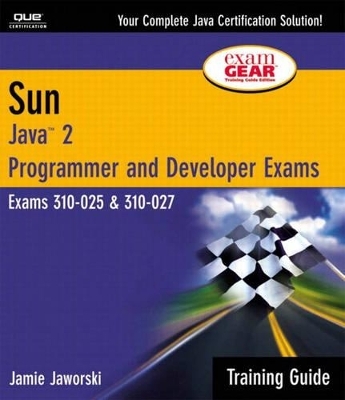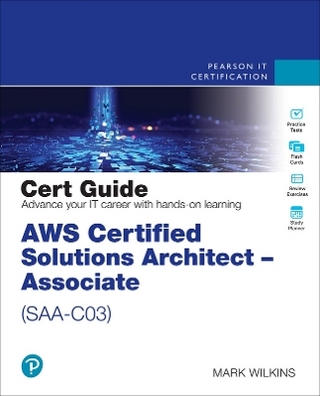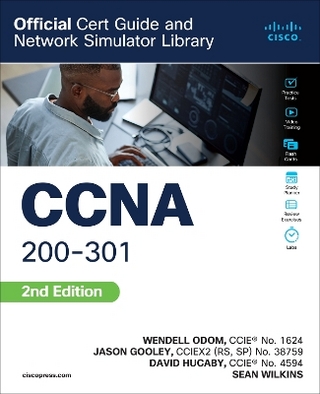
Sun Certification Training Guide
Pearson IT Certification
978-0-7897-2765-7 (ISBN)
- Titel ist leider vergriffen;
keine Neuauflage - Artikel merken
This book helps readers pass the Java certification exams by mapping the content directly to the exams' objectives. This feature helps readers quickly and easily understand test objectives, which maximizes their study time. This book is technically accurate and satisfies the reader's primary objective: to pass the exam. It meets these needs with Objective Explanations, Case Studies, Lab and Step-by-Step Exercises, Multiple Self-Assessment Opportunities, Study Strategies, Exam Tips, Review Breaks and Summaries, Key Terms, Notes, Warnings, and Fast Facts.
Jamie Jaworski is a professional Java developer and Sun certified Java programmer, developer, and architect who consults in the areas of Java development and information security. Jamie has written several best- selling books on Java and JavaScript, including Java 2 Platform Unleashed (Sams, 1999) and Mastering JavaScript and JScript (Sybex, 1999).
I. BECOMING A SUN CERTIFIED JAVA 2 PROGRAMMER.
1. Overview of the Java Programmer Exam.
Introduction. What the Exam Covers. How the Exam Is Given. Being a Great Programmer Is Not Enough. How to Prepare for the Exam. How to Take the Exam.
2. Language Fundamentals.
Introduction. The Structure of Java Programs. Identifying Packages. Importing Classes and Interfaces from Other Packages. The main() Method. Comments. Identifiers and Keywords. Primitive Types and Literal Values.
3. Operators and Assignments.
Introduction. Java Operators. Bitwise Operators. Shift Operators. Comparison Operators. Logical Operators. Assignment Operators. The Cast Operator. The Ternary Operator. Operator Precedence and Order of Evaluation.
4. Declarations and Access Control.
Introduction. Declaring and Using Variables. Declaring and Using Methods. Declaring Initializers. Access Modifiers. Other Modifiers.
5. Flow Control and Exception Handling.
Introduction. Java Statements. Selection Statements. Iteration Statements. Throwing and Catching Exceptions.
6. Overloading, Overriding, Runtime Type, and Object Orientation.
Introduction. Object-Oriented Programming and Java. Object Composition and Reuse. Declaring Classes. Constructors. Declaring Interfaces. Inner and Anonymous Classes. Overloading Methods. Overriding Methods.
7. Garbage Collection.
Introduction. What Is Garbage Collection? How Does the Garbage Collector Work? When Is an Object Subject to Garbage Collection? How Is Finalization Performed?
8. Threads.
Introduction. How Multithreading Works. Creating Threads. Thread States. Scheduling. Sleeping and Waking. Stopping, Suspending, and Resuming. Blocking on I/O. Synchronization. Waiting and Notifying.
9. The java.lang Package.
Introduction. The Object, Class, and Package Classes. The ClassLoader, SecurityManager, Runtime, and RuntimePermission Classes. The System Class. The Wrapped Classes. The Math and StrictMath Classes. The Comparable Interface. The String and StringBuffer Classes. Threads and Processes. The Compiler Class. Exceptions and Errors. The Void Class.
10. The java.util Package.
Introduction. The Classes and Interfaces of the java.util Package. The Collections API. Date and Calendar-Related Classes. Internationalization Classes. Other java.util Classes and Interfaces.
11. The java.awt Package: Components and Facilities.
Introduction. Components and Containers. AWT Components. AWT Containers. Menus.
12. The java.awt Package: Layout.
Introduction. Working with Layout Managers. Using Layouts. Layout Managers, Layout Policies, and Containers. Absolute Positioning.
13. The java.awt Package: Event Handling.
Introduction. Handling Events. The JDK 1.02 Event Class. The Classes and Interfaces of the Event Delegation Model. An Event Delegation Example. Overriding a Component's Event Dispatcher.
14. The java.awt Package: Painting.
Introduction. The Canvas and Graphics Classes. Drawing Shapes. Drawing Text. Displaying Bitmapped Images. Clipping.
15. The java.io Package.
Introduction. Streams. The java.io Class Hierarchy. The java.io Interfaces. The InputStream Class. The OutputStream Class. Byte Array I/O. File I/O. The SequenceInputStream Class. Filtered I/O. Piped I/O. Object I/O. The Reader and Writer Classes. Character Array and String I/O. Character Sets and Codings. The InputStreamReader and OutputStreamWriter Classes. The FileReader and FileWriter Classes. Buffered Character I/O. Filtered Character I/O. The PipedReader and PipedWriter Classes. The PrintWriter Class. The RandomAccessFile Class. The StreamTokenizer Class.
II. BECOMING A SUN CERTIFIED JAVA 2 DEVELOPER.
16. Overview of the Java Developer Exam.
Introduction. Testing Objectives. How the Exam Is Given. The Programming Assignment. The Essay Exam. What the Exam Covers. How to Prepare for the Exam. How to Take the Exam.
17. Developing User Interfaces with Swing.
Introduction. Introducing Swing. Swing GUI Building. Swing Event Handling. Swing Applets. Converting to Swing.
18. Writing Client-Server Applications Using java.net.
Introduction. The Internet Protocol Suite. Client/Server Computing and the Internet. Inside java.net. Web-Related Classes.
19. Accessing Databases Using JDBC.
Introduction. Introducing Relational Databases. One-Tier, Two-Tier, and Three-Tier Database Architectures. Remote Database Access and Drivers. Setting Up a Database. Connecting to a Database. Working with Result Sets. Executing SQL Statements. JDBC 2.0 and a New Approach for Updating Records.
20. Developer Assignment Guide.
Introduction. What You Must Do. Planning and Documentation. Assignment Deliverables. Assignment Objective. Assignment Requirements. Design Patterns. Implementation.
III. FINAL REVIEW.
Fast Facts: Becoming a Sun Certified Java 2 Programmer.
Fast Facts: Becoming a Sun Certified Java 2 Developer.
Study and Exam Prep Tips.
Practice Exam: Becoming a Sun Certified Java 2 Programmer.
Practice Exam: Becoming a Sun Certified Java 2 Developer.
IV. APPENDIX.
Appendix A. What's on the CD-ROM.
Index.
| Erscheint lt. Verlag | 4.7.2002 |
|---|---|
| Verlagsort | Upper Saddle River |
| Sprache | englisch |
| Maße | 202 x 233 mm |
| Gewicht | 1292 g |
| Themenwelt | Mathematik / Informatik ► Informatik ► Web / Internet |
| Informatik ► Weitere Themen ► Zertifizierung | |
| ISBN-10 | 0-7897-2765-X / 078972765X |
| ISBN-13 | 978-0-7897-2765-7 / 9780789727657 |
| Zustand | Neuware |
| Haben Sie eine Frage zum Produkt? |
aus dem Bereich


